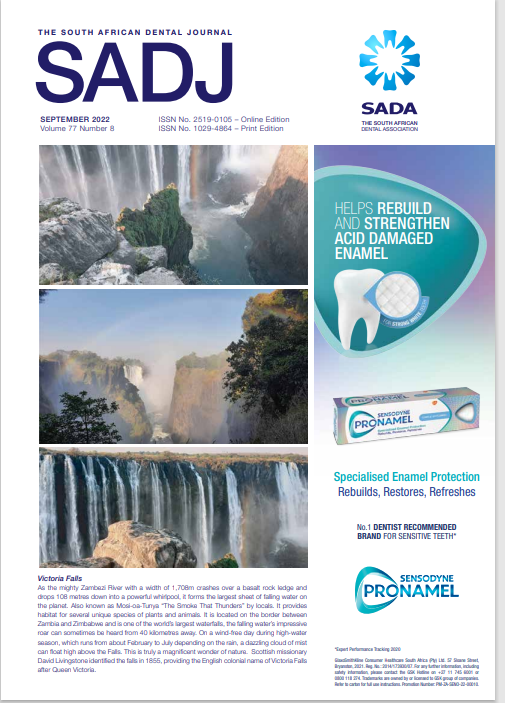Assessing the antibacterial properties of eggshell-titanium powder
DOI:
https://doi.org/10.17159/2519-0105/2022/v77no8a5Keywords:
Antibacterial; eggshell; Mechanochemical; titanium dioxideAbstract
The global distribution of oral diseases caused by bacterial and the severity of their consequences constitute a pandemic condition.
The present paper reports on the antibacterial properties of a modified eggshell and titanium dioxide using the mechanochemical method. EB@TiO2 was modified and characterized using X-raydiffraction (XRD) while the degradation condition was
studied using Thermogravimetric analysis (TGA).The inhibitory properties of EB@TiO2at differentconcentrations (2:1; 3:1 and 4: 1) against both Grampositive (E. coli) and negative bacterial (B. Cereus)strain were studied the using disk diffusion method.
The XRD result confirmed the presence of a thermodynamically stable calcite structure, which is indicative of calcium carbonate. The diffraction peak of the XRD at 2θ = 29.5o suggests the deposition of TiO2 on the surface of CaCo3. TGA curves shows the decomposition of anatase form of titanium dioxide and calcium carbonate. The study evidently shows the antibacterial activities of EB@TiO2 against Escherichia coli and B. Cereus. The salient feature of the study finding is that modifying eggshells with titanium dioxide improves the antibacterial properties, and thus offers a promising role for the development of potent d
Downloads
References
Onwubu S, Mduli P, Singh S, Bharuth V. An in vitro examination on the effectiveness of commercial toothpastes in the prevention of tooth decay, using eggshell as a substitute for human tooth material. S. Afr. Dent. J. 2018;73(7):446-51.
Zanella-Calzada LA, Galván-Tejada CE, ChávezLamas NM, Gracia-Cortés M, Carmen D, MorenoBáez A, et al. A Case–Control Study of SocioEconomic and Nutritional Characteristics as Determinants of Dental Caries in Different Age Groups, Considered as Public Health
Problem: Data from NHANES 2013–2014. Int. J. Environ. Res. Public Health. 2018;15(5):957.
Petersen PE, Ogawa H. Prevention of dental caries through the use of fluoride–the WHO approach. Community Dent. Health. 2016;33(2):66-8.
Nurelhuda NM, Al-Haroni M, Trovik T, Bakken V. Caries experience and quantification of Streptococcus mutans and Streptococcus sobrinus
in saliva of Sudanese schoolchildren. Caries Res. 2010;44(4):402-7.
Tanner A, Kressirer C, Rothmiller S, Johansson I, Chalmers N. The caries microbiome: implications for reversing dysbiosis. Adv. Dent. Res. 2018;29(1):78-85.
Koo H, Bowen WH. Candida albicans and Streptococcus mutans: a potential synergistic alliance to cause virulent tooth decay in children.
Future Microbiol. 2014;9(12):1295-7.
Clark-Perry D, Levin L. Comparison of new formulas of stannous fluoride toothpastes with other commercially available fluoridated toothpastes: A systematic review and meta-analysis of randomised controlled trials. Int. Dent. J. 2020;70(6):418-26.
Beltran E. Fluoride in toothpastes for children: suggestion for change. Pediatr Dent. 1988;10:185-8.
Lacson CFZ, Lu M-C, Huang Y-H. Fluoridecontaining water: A global perspective and a pursuit to sustainable water defluoridation management-An overview. J. Clean. Prod. 2021;280:124236.
Xia Y, Huang X, Li W, Zhang Y, Li Z. Facile defluoridation of drinking water by forming shell@ fluorapatite nanoarray during boiling egg shell. J. Hazard. Mater. 2019;361:321-8.
Waheed M, Yousaf M, Shehzad A, Inam-UrRaheem M, Khan MKI, Khan MR, et al. Channelling eggshell waste to valuable and utilizable products: a comprehensive review. Trends Food Sci Technol. 2020;106:78-90.
Onwubu SC, Vahed A, Singh S, Kanny KM. Reducing the surface roughness of dental acrylic resins by using an eggshell abrasive material. J Prosthet Dent. 2017;117(2):310-4.
Mony B, Ebenezar AR, Ghani MF, Narayanan A. Effect of Chicken Egg Shell Powder Solution on Early Enamel Carious Lesions: An Invitro Preliminary Study. J. Clin. Diagnostic Res. 2015;9(3):ZC30.
Onwubu SC, Mdluli PS, Singh S, Lawrence M, Ngombane Y. Characterization and in vitro evaluation of an acid resistant nanosized dental eggshelltitanium dioxide material. Adv Powder Technol. 2019:1-8.
Rana S, Misra R. The anti-microbial activity of titania-nickel ferrite composite nanoparticles. JOM. 2005;57(12):65-9.
Rawat J, Rana S, Srivastava R, Misra RDK. Antimicrobial activity of composite nanoparticles consisting of titania photocatalytic shell and
nickel ferrite magnetic core. Mater. Sci. Eng. C. 2007;27(3):540-5.
Onwubu SC, Mdluli PS, Singh S. Evaluating the buffering and acid-resistant properties of eggshell–titanium dioxide composite against erosive acids. J. Appl. Biomater. Funct. Mater. 2019;17(1):1-7.
Lin H, Dong Y-b, Jiang L-y. Preparation of calcium carbonate particles coated with titanium dioxide. Int. J. Miner. Metall. Mater. 2009;16(5):592-7.
Wiegand I, Hilpert K, Hancock RE. Agar and broth dilution methods to determine the minimal inhibitory concentration (MIC) of antimicrobial substances. Nat Protoc. 2008;3(2):163-75.
Chaudhuri B, Mondal B, Modak D, Pramanik K, Chaudhuri B. Preparation and characterization of nanocrystalline hydroxyapatite from egg shell and K2HPO4 solution. Mater. Lett.. 2013;97:148-50.
Torlak E, Korkut E, Uncu AT, Şener Y. Biofilm formation by Staphylococcus aureus isolates from a dental clinic in Konya, Turkey. J. Infect. Public Health. 2017;10(6):809-13.
Patra JK, Kim ES, Oh K, Kim H-J, Kim Y, Baek K-H. Antibacterial effect of crude extract and metabolites of Phytolacca americana on pathogens responsible for periodontal inflammatory diseases and dental caries. BMC Complement Altern Med. 2014;14(1):1-6.
Kawada-Matsuo M, Komatsuzawa H. Role of Streptococcus mutans two-component systems in antimicrobial peptide resistance in the oral cavity. Jpn Dent Sci Rev. 2017;53(3):86-94.
Liu Y, Liu P, Wang L, Shi Y, Chen J, Wang H, et al. RESEARCH < 487Inhibitory effects of citrus lemon oil and limonene on Streptococcus sobrinus–Induced dental caries in rats. Arch. Oral Biol. 2020;118:104851.
Caufield P, Schön C, Saraithong P, Li Y, Argimón S.Oral lactobacilli and dental caries: a model for niche adaptation in humans. J. Dent. Res. 2015;94(9_suppl):110S-8S.
Depan D, Misra R. On the determining role of network structure titania in silicone against bacterial colonization: mechanism and disruption of biofilm. Mater. Sci. Eng. C. 2014;34:221-8.
Sepehrnia N, Mahboubi AA, Mosadeghi MR, Khoda KG, Safari SA. Effect of calcium carbonate and calcium sulfate on E. coli survival in fine sand mixtures. J. Environ. Sci. Stud. 2012;38(62):37-9.
Saini R, Saini S, Sharma S. Biofilm: A dental microbial infection. J Nat Sci Biol Med. 2011;2(1):71.
29. Dhakal A, Sundaram S, Rajesh V, Rajan RJAP. Comparative antimicrobial efficacy study of different commercially available toothpaste in In-dia: An in vitro study. DRC Sustainable Future: Journal of Environment, Agriculture, and Energy 2021;2(2):122-31.
Downloads
Published
Issue
Section
License

This work is licensed under a Creative Commons Attribution-NonCommercial 4.0 International License.





.png)